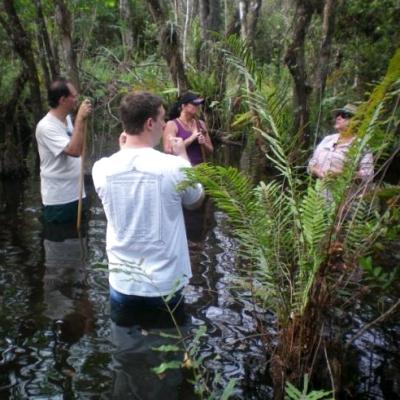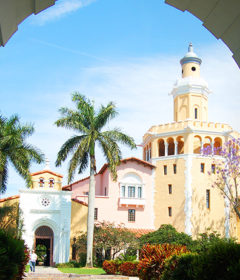Law Institute committed to environment

Stetson University College of Law continues its commitment to environmental education, scholarship, and service from the local to the global scale. Stetson’s environmental programs are coordinated through its Institute for Biodiversity Law and Policy. Activities for 2011-2012, as included in the Institute’s Annual Report, included the following:
Contributing to worldwide conservation efforts: In Spring 2012, the Biodiversity Institute collaborated with the Regional Office for Latin America and the Caribbean of the United Nations Environment Programme (UNEP) on its Mangrove Project. Two J.D. students, Marcela Bonells and Erin Okuno, and an LL.M. student, Juan Zarama, prepared a research report in Spanish exploring legal and policy coastal management tools to assist with the implementation of a municipal coastal development plan in Laguna de Perlas, Nicaragua. The students briefed Lucia Scodanibbio, UNEP Mangrove Project Officer, and Balbo Muller, national coordinator of the municipal coastal plan, via Skype.
Marcela Bonells served as an extern at the Ramsar Convention Secretariat in Gland, Switzerland, during summer 2011. During her time at the Secretariat, she and Monica Zavagli, the Project Officer for the Ramsar Scientific and Technical Review Panel (STRP), prepared an information paper on the diversity and benefits of National Ramsar Committees. The paper was published in a special issue of the Journal of International Wildlife Law & Policy. In December 2011, Ms. Bonells presented the paper (in Spanish) at the Ramsar Pan American regional meeting in Kingston, Jamaica.
The Biodiversity Institute played a significant role in the adoption of a resolution on wetland conservation at the Eleventh Meeting of the Conference of the Parties of the Ramsar Convention on Wetlands inBucharest,Romania, in July 2012. Professor Gardner, who serves as an STRP invited expert, introduced the draft resolution, which provides a global framework to avoid, mitigate, and compensate for wetland impacts.
Marcela Bonells, Erin Okuno, and Juan Zarama conducted research to support the draft resolution. Professor Gardner and the students co-authored a Briefing Note that reviewed wetland laws and policies throughout the world, which was published by the Ramsar Secretariat. Stetson students, including exchange students from the University of Toulouse, translated the Briefing Note into Spanish and French, the other official languages of the convention.
The draft resolution was produced in part at a Ramsar workshop that Stetson hosted at its Tampa Law Center in October of 2010, and in part at a Ramsar workshop hosted by the Centre for Ecology and Hydrology in theUKin July of 2011. The final resolution, which was adopted by consensus, expresses appreciation to both Stetson and the UK government.
Using innovative methods to teach environmental law: During academic year 2011-2012, the Biodiversity Institute conducted an Ecosystem Banking Workshop, a voluntary enrichment program for students. Over the course of the year, the students learned about market-based approaches to restoring wetlands, conserving endangered species habitat, improving water quality, and reducing greenhouse gas emissions. The workshop concluded with students presenting case studies. One of the goals of the workshop is to serve as a feeder program for internships with regulatory agencies and environmental groups. Summer internship placements included the Sacramento field office of the U.S. Fish and Wildlife Service and the Environmental Bureau of the New York Attorney General’s Office.
In the fall, student editors for the Journal of International Wildlife Law and Policy and students from Professor Ezequiel Lugo’s International Environmental Law course performed extensive research and wrote case studies for the Ramsar Secretariat about National Committees under biodiversity-related multilateral environmental agreements. Students wrote about fifteen different National Committees under CITES, the CBD, UNCCD, and UNFCCC. Several students presented their findings to the Ramsar Deputy Secretary General and the STRP Chair during a videoconference. The executive summary was shared with the Intergovernmental Platform on Biodiversity and Ecosystem Services (IPBES), and the STRP Newsletter highlighted the students’ work.
This spring Professor Lance Long taught Research and Writing II – Environmental Law. The course covered the same skills as other sections of Research and Writing II, but all the problems had an environmental focus. In addition to the traditional appellate brief (which involved whether hydrofracking required a Clean Water Act permit), the students drafted—and submitted— comment letters to the Bureau of Land Management (BLM) on proposed rules covering leases for wind and solar energy on BLM lands.
In March, Professors Boudreaux,Gardner, and Long took a group of students (from the RW2 class and the Ecosystem Banking Workshop) on a swamp walk and canoe trip through Big Cypress National Preserve.
In recognition of the strong environmental offerings at Stetson, the faculty approved a new concentration program in Environmental Law.
Producing scholarship that makes a difference: Stetson professors tie their scholarship to real world issues. For example, Professor Paul Boudreaux’s book, The Housing Bias: Rethinking Land Use Laws for a Diverse New America, was published by Palgrave Macmillan in August 2011. At the Ramsar Pan American meeting in Jamaica, the Ramsar Secretariat launched the Spanish version of Wetlands in the Americas. The work assesses the status of Ramsar implementation in the Americas, and Professor Gardner and Maria Rivera, Ramsar Senior Advisor for theAmericas, served as general editors. And Professor Peter Fitzgerald is breaking new ground with his book, International Issues in Animal Law, published in August 2012 by Carolina Academic Press.
In Fall 2012, Professor Fitzgerald will serve as a Visiting Academic Advisor to the Law Commission of England and Wales to assist with its Wildlife Law Reform Project. This is the first time an American academic lawyer has ever been privileged to work in this capacity with the Law Commission, which is an independent body within the British Government that is supported by the Ministry of Justice and directly advises Parliament. The Wildlife Law Reform Project not only involves direct participation in a substantial revision of existing UK law, but also a rare attempt by a common law country to fundamentally and comprehensively modernize a host of legal measures affecting diverse interests in wildlife—which will necessarily touch upon many of the key issues central to the rapidly evolving field of animal law. As such, it will be closely watched by those both within and without the UK.
Stetson also continues to serve as the host school for the Journal of International Wildlife Law and Policy, a peer-reviewed journal which is published quarterly. Students with a demonstrated interest in wildlife issues edit articles submitted by academics, policy makers, and scientists. A highlight this year was the special issue on the 40th anniversary of the Ramsar Convention.
Creating a dialogue about environmental challenges: Each semester, the Biodiversity Institute offers the Edward and Bonnie Foreman Biodiversity Lecture Series, which is free and open to the public. The Spring 2012 lecturers were: Gary Lytton, Director, Rookery Bay National Estuarine Research Reserve, Managing the Balancing Act: Land Use and Environmental Protection at the Rookery Bay National Estuarine Research Reserve; Mauricio Roma, Geologist, and Philip Bein, Watershed Inspector General, Environmental Bureau, New York Attorney General’s Office, Hydrofracking: Environmental Risks and Legal Responses; and Hon. Judith M. Barzilay, U.S. Court of International Trade, The Role of the U.S. Court of International Trade in Environmental Protection.
In June 2011, we sponsored the 13th International Wildlife Law Conference at the University of Granada. The keynote presenter was Professor Marc Pallemaerts of the University of Amsterdam and Institute for European Environmental Policy. Plans are underway for the 14th International Wildlife Law Conference at the University of Buea in Cameroon in December.
And, of course, we also organized the 16th Annual Stetson International Environmental Moot Court Competition. Teams competed in regionals in Africa, Asia, Europe, North America, and South America. Stetson hosted the International Finals, which included student advocates from Australia, Brazil, China, India, Ireland, Nepal, the Philippines, South Korea, Ukraine, the United States, Vietnam, and Zimbabwe. We had a fantastic moot, thanks to the organization of Professor Brooke Bowman and the support of the entire Stetson community: students, staff, and faculty. Our visitors continue to rave about your hospitality and warmth.
Thanks again for your support this year!



